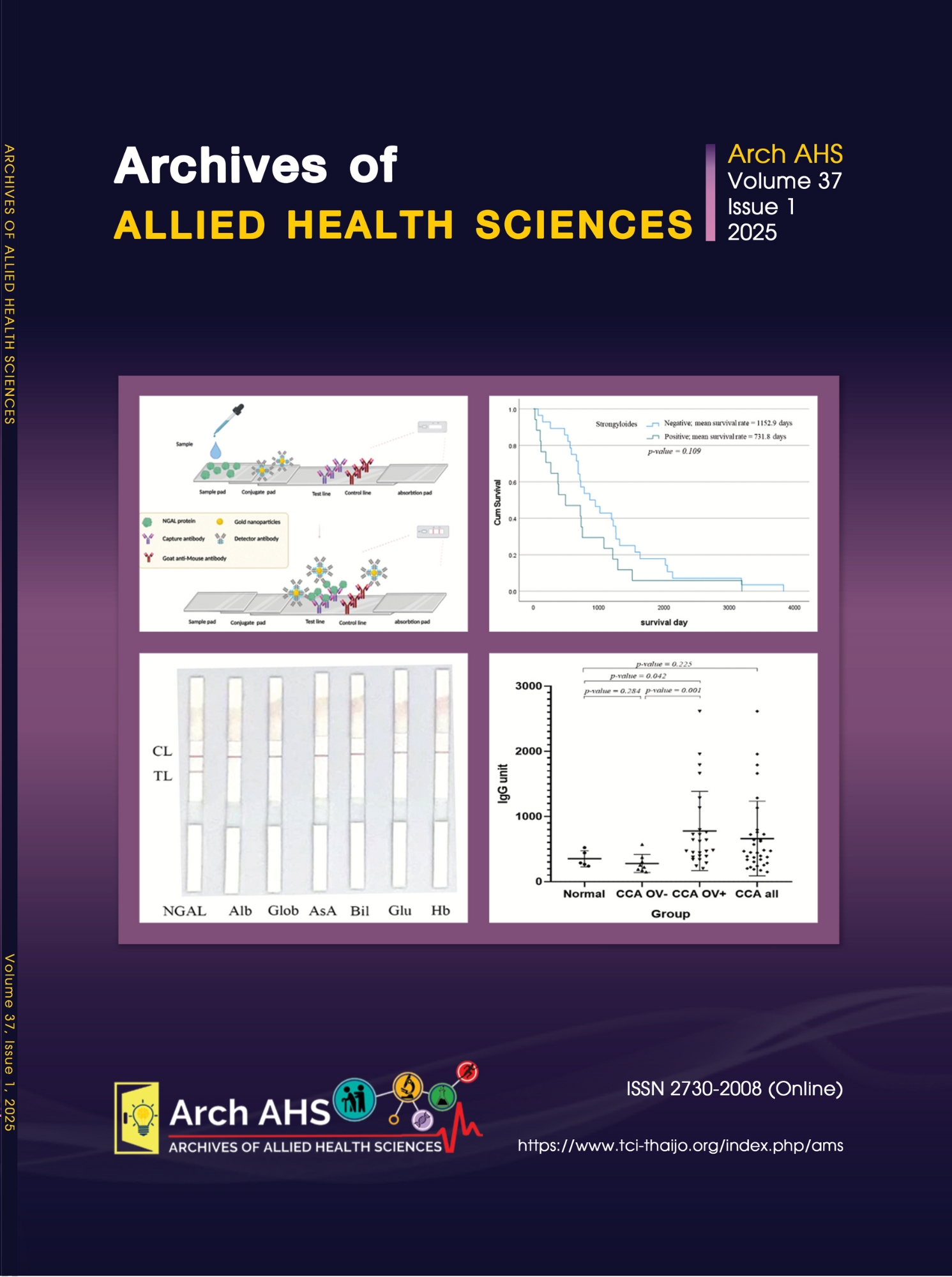Thai version of Family Impact of Assistive Technology Scale for Adaptive Seating (FIATS-AS-Th): Cross-cultural adaptation and preliminary reliability in children with cerebral palsy
Main Article Content
Abstract
Adaptive seating devices provide postural support to children with cerebral palsy who have difficulty sitting independently due to neurological impairments. They help enhance sitting stability and are useful for both children with cerebral palsy and their families. Little evidence exists on the effectiveness of adaptive seating devices from the perspective of parents or other family members who are crucial in caring for their children. The Family Impact of Assistive Technology Scale for Adaptive Seating (FIATS-AS) is a parent-reported measure of adaptive seating interventions for children. While the English version of the FIATS-AS is useful, the cross-cultural adaptation is needed to improve its utility in other cultural settings. Thus, the aims of this study were to develop a Thai version of the Family Impact of Assistive Technology Scale (FIATS-AS-Th) and estimates its internal consistency and test-retest reliability. Translation and cross-cultural adaptation of the FIATS-AS into Thai version were conducted using standardized process. Thirty primary caregivers of the children with cerebral palsy (aged 2-11 years) and Gross Motor Function Classification System levels 4-5 completed Thai version of the FIATS-AS twice at 2-week intervals to estimate internal consistency and test-retest reliability. For the internal consistency, the Cronbach’s alpha was 0.84 for total scale and ranged from 0.63-0.85 for its subscales. For test-retest reliability, the intraclass correlation coefficient (ICC 3,1) for the total scores was 0.97 (95% confidence interval (CI) = 0.91 - 0.99). The ICC point estimates for subscales between 0.86-0.96 (95% CI = 0.44 - 0.99). The FIATS-AS-Th is an emerging a reliable measure of the functional impact of adaptive seating device on children with CP and their families.
Article Details

This work is licensed under a Creative Commons Attribution-NonCommercial-NoDerivatives 4.0 International License.
References
Rosenbaum P. Cerebral palsy: what parents and doctors want to know. BMJ 2003; 3(326): 970-4.
Mutlu A, Bugusan S, Kara O. Impairments, activity limitations, and participation restrictions of the international classification of functioning, disability, and health model in children with ambulatory cerebral palsy. SMJ 2017; 38(2): 176-85.
Peters VB, Blauw-Hospers CH, Dirks T, Bakker H, Bos AF, Hadders-Algra M. Development of postural control in typically developing children and children with cerebral palsy: Possibilities for intervention?. Neurosci Biobehav Rev 2007; 31(8): 1191-200.
Abdallah MA, Soliman FAM. Prevalence of the need for adaptive seating systems among children with cerebral palsy in Egypt. Prosthet Orthot Int 2022; 46(1): 7-11.
Gough M. Continuous postural management and the prevention of deformity in children with cerebral palsy: an appraisal. Dev Med Child Neurol 2009; 51(2): 105-10.
Gericke T. Postural management for children with cerebral palsy: consensus statement. Dev Med Child Neurol 2006; 48(4): 244.
Angsupaisal M, Maathuis CG, Hadders-Algra M. Adaptive seating systems in children with severe cerebral palsy across International Classification of Functioning, Disability and Health for Children and Youth version domains: a systematic review. Dev Med Child Neurol 2015; 57(10): 919-30.
Ryan SE, Campbell KA, Rigby PJ, FishbeinGermon B, Hubley D, Chan B. The impact of adaptive seating devices on the lives of young children with cerebral palsy and their families. Arch Phys Med Rehabil 2009; 90(1): 27-33.
Henderson S, Skelton H, Rosenbaum P. Assistive devices for children with functional impairments: impact on child and caregiver function. Dev Med Child Neurol 2008; 50(2): 89-98.
Ryan SE, Campbell KA, Rigby PJ, Germon B, Chan B, Hubley D. Development of the new Family Impact of Assistive Technology Scale. Int J of Rehabil Res 2006; 29(3): 195-200.
Ryan SE, Campbell KA, Rigby PJ. Reliability of the family impact of assistive technology scale for families of young children with cerebral palsy. Arch Phys Med Rehabil 2007; 88(11): 1436-40.
Beaton DE, Bombardier C, Guillemin F, Ferraz MB. Guidelines for the process of cross-cultural adaptation of self-report measures. Spine 2000; 25(24): 3186-91.
Davis E, Davern M, Waters E, Boyd R, Reddihough D, Mackinnon A, et al. Cerebral palsy quality of life questionnaire for adolescents (CP QOL-Teen) manual. Melbourne: University of Melbourne; 2013.
Portney LG, Watkins MP. Foundations of clinical research applications to practice. 3rd ed. USA: Pearson Prentice Hall; 2009.
Streiner DL, Norman GR. Health measurement scales a practical guide to their development and use. 4th ed. New York: Oxford university press; 2008.
Ryan SE, Sawatzky B, Campbell KA, Rigby PJ, Montpetit K, Roxborough L. Functional outcomes associated with adaptive seating interventions in children and youth with wheeled mobility needs. Arch Phys Med Rehabil 2014; 95(5): 825-31.
Simsek TT, Simsek IE, Ryan SE, Yakut Y, Uygur F. The Turkish version of the family impact of assistive technology scale: a validity and reliability study. Scand J Occup Ther 2012; 19(6): 515-20.
Stier CD, Chieu IB, Howell L, Ryan SE. Exploring the functional impact of adaptive seating on the lives of individual children and their families: a collective case study. Disabil Rehabil Assist Technol 2017; 12(5): 450-6.
Ryan SE. Lessons learned from studying the functional impact of adaptive seating interventions for children with cerebral palsy. Dev Med Child Neurol 2016; 50(4): 78-82.

